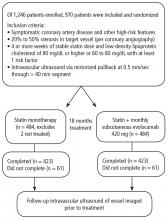Results of the GLAGOV trial
ABSTRACT
Statins therapy reduces atheroma in proportion to the reduction of low-density lipoprotein cholesterol (LDL-C). Proprotein convertase subtilisin–kexin type 9 (PCSK9) inhibitors are a new class of injectable human monoclonal antibodies shown to lower LDL-C when added to statin therapy. In a randomized, double-blind, placebo-controlled study, 968 patients with symptomatic coronary artery disease were treated with statins alone or combined with the PCSK9 inhibitor, evolocumab, and assessed for change in percent, total volume, and regression of coronary atheroma. Treatment with statins plus evolocumab achieved mean LDL-C levels of 36.6 mg/dL, produced atheroma regression with a mean change in percent of atheroma volume of about 1% (P < .001), and induced regression in a greater percentage of patients. The clinical benefits of LDL-C as low as 20 mg/dL shown in this trial warrant further investigation.
KEY POINTS
- Statin therapy achieves regression of atherosclerosis in proportion to reductions in LDL-C.
- PCSK9 inhibitors are a new class of injectable human monoclonal antibodies shown to lower LDL-C when added to statin therapy.
- Treatment with statins plus the PCSK9 inhibitor, evolocumab, achieved mean LDL-C levels of 36.6 mg/dL, atheroma regression, and demonstrated clinical benefit for LDL-C as low as 20 mg/dL.
Intravascular ultrasonography (IVUS) has been used for the past 20 years to measure atheromatous plaque in patients with coronary artery disease. The total volume of atherosclerosis in a coronary artery segment can be calculated using IVUS. A rotating transducer produces an image of a single, cross-sectional slice of the artery from which the atheroma area is calculated. A motorized device is used to withdraw the catheter, obtaining a series of cross-sectional slices at 1-mm intervals. The atheroma area for each slice is summated to obtain the total volume of atherosclerosis in the artery.
IVUS has demonstrated that statins slow the progression or even induce regression of coronary atherosclerosis in proportion to the degree of reduction in low-density lipoprotein cholesterol (LDL-C).1–4 No LDL-C-lowering therapy other than statins has shown regression of atherosclerosis in a trial using IVUS. The lowest LDL-C achieved in prior trials using statins was about 60 mg/dL.1,3 While this is very low, lower levels have not previously been explored.
Proprotein convertase subtilisin–kexin type 9 (PCSK9) inhibitors, a new class of drugs, are injectable, fully human monoclonal antibodies that inactivate the PCSK9 protein. PCSK9 inhibitors have been shown to lower LDL-C incrementally when added to statins, achieving very low LDL-C levels.5,6 However, no data exist describing the effect of low LDL-C levels reached using PCSK9 inhibitors on the progression of atherosclerosis.









